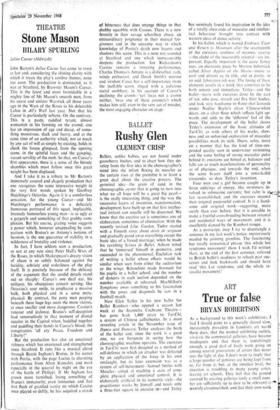True or false
ART BRYAN ROBERTSON
As a background to this week's exhibitions, I feel I should point to a generally shared view, increasingly prevalent in London's art world these days, that the normal exhibiting outlets, vis-à-vis the commercial galleries, have become inadequate and that there is, tantalisingly enough, a good deal of lively work going on among several generations of artists that never sees the light of day. I don't want to imply that a large number of geniuses are being kept from us, far from it; but, at the simplest level, the situation is troubling to 'many young artists leaving art schools. They feel that the ground covered by existing galleries (only a small num, ber are sufficiently up to date to be relevant) is severely circumscribed; and that their own work As a background to this week's exhibitions, I feel I should point to a generally shared view, increasingly prevalent in London's art world these days, that the normal exhibiting outlets, vis-à-vis the commercial galleries, have become inadequate and that there is, tantalisingly enough, a good deal of lively work going on among several generations of artists that never sees the light of day. I don't want to imply that a large number of geniuses are being kept from us, far from it; but, at the simplest level, the situation is troubling to 'many young artists leaving art schools. They feel that the ground covered by existing galleries (only a small num, ber are sufficiently up to date to be relevant) is severely circumscribed; and that their own work
may not readily slot into the four or five clearly marked areas of taste promoted by these dealers.
As an artist, you are then faced with two alternatives. Either you prepare to go under- ground for quite a long while, scraping a living from teaching and sustaining belief in your work by will-power and the encouragement of whatever family and close friends are available —or else you modify your work in some way, shaping it to the taste existing in one or other of the operative galleries. The first solution is getting harder to implement as teaching posts grow scarcer. The second—work tailored to the policies of the galleries—is theoretically un- thinkable: except that there is, I'm certain, a good deal of thin work around which has, in practice, achieved just that pitch of delicate corruption. And it is hard for either the dealers or their clients to tell the difference.
It is not easy to provide glib solutions, though we still seem to need one or two more galleries in the West End with policies which offer some alternative to those• already so strongly in evi- dence. And the Arts Council must extend its good work of allowing contemporary British artists to exhibit occasionally (between 'official' shows!) at the Hayward Gallery; it's a good idea which only needs more thought—and cour- age—to be a big help all round. A lot of what I've said is conditioned by the awkward factor of scale, too: many artists are working along lines which make it impossible for the small. commercial galleries to accommodate what they're doing. But there's also the plain fact of good work either undiscovered, or ignored be- pause it falls between the present sharp lines of demarcation.
_ In saying that it is hard for the public, let alone the dealers, to differentiate between true and false in painting and sculpture now, I should add that the position would be immensely clari- fied if artists were actually employed occasion- ally, but they are not. There's an immense amount of good, competent, well-made work around, which lacks entirely what used to be called the divine spark but would still be quite serviceable in the fields of commercial art or design, or in the theatre. If our artists were sometimes used in these ways, instead of being fenced off inside the increasingly artificial world of easel painting, an automatic sieving process would take place and many artists would find their proper, and perfectly happy, level. Mean- while, confusion, doublethink and square miles of so-called 'didactic' art, or 'art-debate' art, reign supreme and no advance is made.
I certainly don't feel it's being made at the Redfern, where Peter Sedgley is showing a num- ber of rotating discs ('video-rotors') whose con- centric patterning and fluorescent colour come to life when ultra-violet and stroboscopic light is focused on them. They're quite pretty, very lightweight, not interesting for more than a minute or two, and this kind of activity is now in perilous competition with commercial art and the discotheques of Los Angeles, Toronto, or London. Nice for the theatre, too, probably, but as isolated objects for solemn contempla- tion they're not enough. That arch-villain Duchamp did them first anyway, donkey's years ago. Maybe there's some steady progress at the Waddington, where David Annesley is showing five coolly calculated and highly agreeable metal sculptures, camouflaged by excellent colour, all slightly beyond manscale, in which two, three, four or five elements (circles and triangles, :always) are loaded sparsely or densely into big containing circles. Consistent with earlier work and well worth attention.







































 Previous page
Previous page